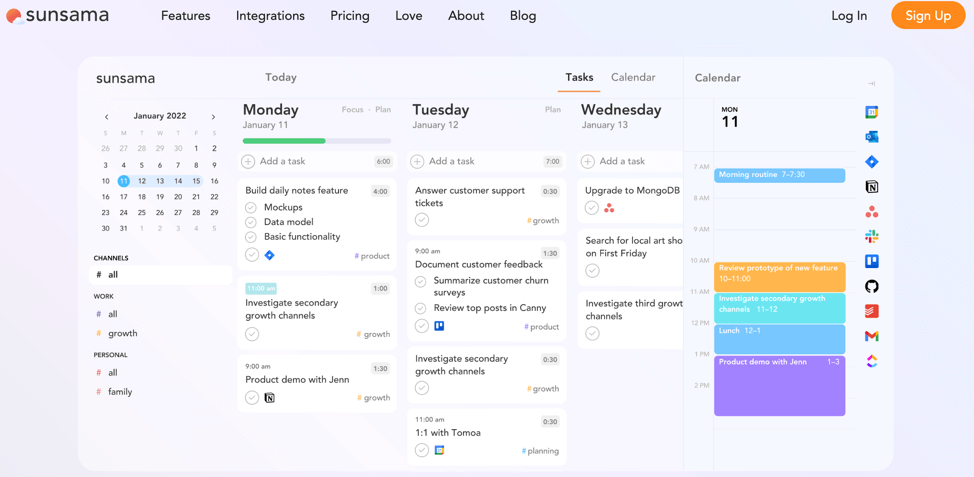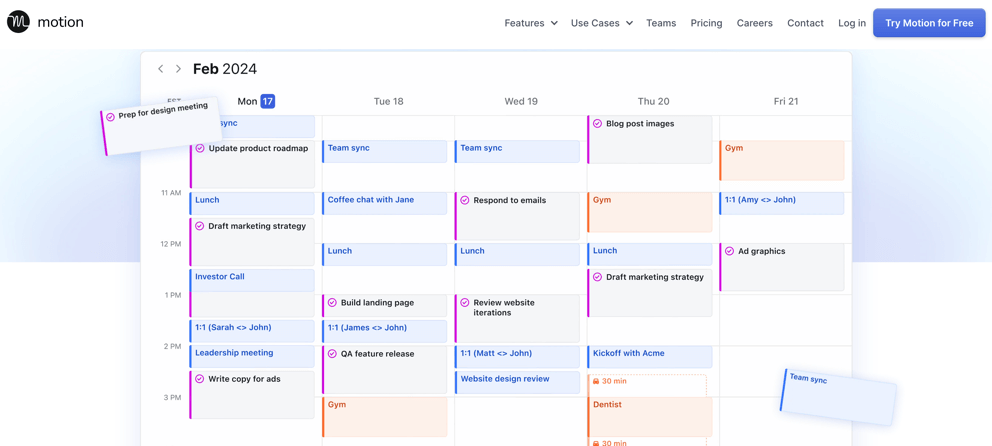Managing your time effectively and staying productive is crucial for success. With numerous productivity tools available, choosing the right one can be overwhelming.
Two popular options that have gained significant attention are Sunsama and Motion. Both tools promise to streamline your workflow, help manage tasks, and boost productivity.
But which one is right for you?
In this article, we will provide a detailed comparison between Sunsama and Motion to help you make an informed decision.
What is Sunsama?

Sunsama, founded in 2018, is a daily planner designed to help users focus on their most important tasks. It combines task management with calendar integration, allowing for a holistic approach to productivity. Sunsama aims to balance work and personal life by encouraging mindful planning.
Key Features of Sunsama
- Daily Planning and Task Management: Sunsama allows users to plan their day by dragging tasks from various sources into a daily agenda. This helps prioritize and manage workloads effectively.
- Integration with Other Tools: Sunsama integrates with popular tools like Trello, Asana, and Google Calendar, providing a seamless workflow.
- Focus Mode and Time Blocking: The focus mode helps users concentrate on one task at a time, while time blocking ensures that tasks are completed within set time frames.
- Collaboration Tools: Sunsama supports team collaboration by enabling task sharing and collective progress tracking, which is ideal for project management.
- Task Tracking and Progress Monitoring: Users can track the progress of their tasks throughout the day, making adjustments as needed. This helps in staying focused and on track.
Examples of Use Cases
- Project Managers: Sunsama helps project managers keep track of various tasks and deadlines, ensuring that projects stay on schedule.
- Freelancers: Freelancers can manage multiple clients and projects by organizing their tasks effectively within Sunsama.
- Remote Teams: Sunsama’s collaboration features make it easier for remote teams to stay connected and coordinate their efforts.
Pros and Cons
- Pros: User-friendly interface, excellent integration with other tools, effective task and time management features.
- Cons: Limited automation compared to Motion, may require manual adjustments for dynamic schedules.
What is Motion?

Motion is a relatively new player in the productivity tool market, leveraging artificial intelligence to manage and optimize users’ schedules. It focuses on automating calendar management and task prioritization to maximize efficiency.
Key Features of Motion
- AI-Powered Scheduling and Task Management: Motion uses AI to automatically schedule tasks based on deadlines, priorities, and availability.
- Automated Calendar Management: The tool syncs with your calendar to adjust your schedule in real-time, ensuring that you stay on track.
- Task Prioritization and Deadline Tracking: Motion prioritizes tasks based on urgency and importance, helping users meet deadlines.
- Integration with Other Tools: Motion integrates with Google Calendar, Outlook, and other productivity tools, enhancing its utility.
Examples of Use Cases
- Busy Professionals: Motion helps professionals manage their hectic schedules by automating task allocation and prioritization.
- Teams with Dynamic Schedules: Motion’s real-time adjustments make it ideal for teams with frequently changing schedules and priorities.
- Students: Motion assists students in balancing academic and personal commitments by optimizing their schedules.
Pros and Cons
- Pros: Advanced AI-driven scheduling, real-time calendar adjustments, robust task prioritization.
- Cons: A steeper learning curve, may require adaptation to an AI-driven approach.
Pricing: Sunsama vs Motion app
Sunsama Pricing
Sunsama offers a 14-day free trial, allowing users to explore its features before committing to a subscription. The subscription plans are as follows:
- Monthly Plan: $20 per month.
- Annual Plan: $192 per year (equivalent to $16 per month).
Motion Pricing
Motion also offers a free trial, providing a chance to experience its capabilities. The subscription plans are:
- Monthly Plan: $34 per month
- Annual Plan: $228 per year (equivalent to $19 per month).
Value for Money Analysis
While Motion is priced higher than Sunsama, it offers advanced AI features and real-time scheduling adjustments, which can justify the higher cost for users needing these capabilities. Sunsama, on the other hand, provides excellent value for users looking for a straightforward, manual planning tool with strong integrations.
Sunsama vs Motion: Ease of Use
User Interfaces and User Experiences
- Sunsama: Sunsama’s interface is designed for simplicity and ease of use. It is intuitive, making it easy for new users to get started quickly.
- Motion: Motion’s interface is sleek but may be more complex due to its AI-driven features. Users might need some time to adapt to the automated scheduling approach.
Learning Curve
- Sunsama: Minimal learning curve; most users can become proficient within a few days.
- Motion: Moderate learning curve; users need time to understand and adjust to the AI-powered features.
Customer Support and Resources
- Sunsama: Offers comprehensive support resources, including tutorials, FAQs, and community forums.
- Motion: Provides extensive customer support, including onboarding assistance, tutorials, and responsive customer service.
Integration and Efficiency
Integration Capabilities
- Sunsama: Integrates seamlessly with tools like Trello, Asana, and Google Calendar, enhancing its utility for users who rely on multiple productivity tools.
- Motion: Integrates with Google Calendar, Outlook, and other tools, providing a unified platform for task and schedule management.
Impact on Workflow Efficiency
- Sunsama: Enhances workflow by centralizing tasks and schedules from various sources.
- Motion: Maximizes efficiency through automated scheduling and real-time adjustments.
User Reviews and Feedback
Summary of User Reviews
- Sunsama: Users appreciate its user-friendly interface, effective task management, and strong integrations. Common complaints include the lack of advanced automation features.
- Motion: Users praise its AI-driven scheduling and real-time adjustments. Some users find the initial learning curve challenging.
Common Praises and Complaints
- Sunsama Praises: Ease of use, excellent integrations, helpful customer support.
- Sunsama Complaints: Manual adjustments required, higher cost compared to basic planning tools.
- Motion Praises: Advanced AI features, dynamic scheduling, robust task prioritization.
- Motion Complaints: Higher cost, learning curve for new users.
Sunsama Alternatives
Overview of Sunsama Alternative Tools
- Trello: Known for its card-based task management system.
- Asana: Offers comprehensive project management features.
- Todoist: Popular for its simplicity and effectiveness in task management.
Brief Comparison with Motion
While Trello, Asana, and Todoist offer excellent task management features, they lack the AI-driven scheduling and real-time adjustments that Motion provides. Users looking for more automation might prefer Motion over these alternatives.
Motion Alternatives
Overview of Alternative Tools
- TimeHero: Uses AI to schedule tasks and manage projects.
- Clockwise: Optimizes calendar schedules for better time management.
- RescueTime: Focuses on time tracking and productivity analysis.
Brief Comparison with Sunsama
TimeHero, Clockwise, and RescueTime offer unique features that cater to specific needs, such as AI scheduling and time tracking. However, Sunsama’s focus on manual planning and integration with other tools provides a different approach to productivity.
FAQs
Common Questions about Sunsama and Motion:
1. Can I use Sunsama and Motion together?
While it’s possible, it may lead to redundant features. It’s best to choose the one that suits your needs the most.
2. Do both tools offer mobile apps?
Yes, both Sunsama and Motion offer mobile apps for on-the-go productivity.
3. Which tool is better for team collaboration?
Sunsama offers strong collaboration features, making it slightly better for team-based projects.
Conclusion
Sunsama and Motion offer unique features that cater to different productivity needs. Sunsama excels in manual daily planning and integration with other tools, making it ideal for users who prefer a hands-on approach.
Motion stands out with its AI-driven scheduling and real-time adjustments, perfect for users who need dynamic and automated task management.
Ultimately, the choice between Sunsama and Motion depends on your specific productivity requirements and preferences. We encourage you to try both tools to determine which one fits your needs best.


[…] Sunsama vs Motion: A Comprehensive Comparison […]
[…] Sunsama vs Motion: A Comprehensive Comparison […]
[…] Sunsama vs Motion: A Comprehensive Comparison […]